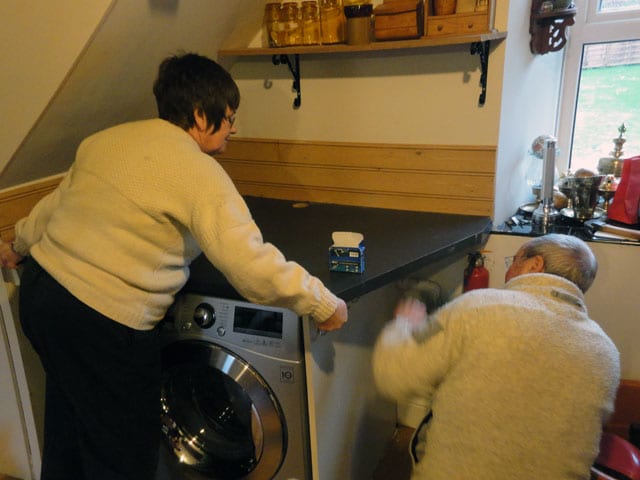Tumble dryers make drying laundry really quick and easy (once you’ve lived with one, you’ll probably wonder how you ever coped without). However, in order to get the best from your tumble dryer, you’ll need to ensure it’s installed in the right way.
The majority of tumble dryers fall into one of two categories: vented dryers, and condenser dryers. The two work in very different ways, and so demand very different installation processes.
Where to install a tumble dryer

Can a condenser tumble dryer go in a cupboard?
In order for a condenser dryer to work, it needs to be able to breathe. This means taking in air that’s cooler than the air within the dryer and expelling air that’s warmer (and richer in moisture). This means you’ll be unable to put the dryer in a confined space, like the inside of a cupboard. Ideally, you’ll want to place the dryer in a wide space with a supply of fresh air. Without this, a condenser dryer will end up reabsorbing the warm, steamy, air that it’s just expelled – preventing it from operating efficiently.
Can a tumble dryer go in a garage?
In order to work correctly, a tumble dryer will need the room’s ambient temperature to be above a certain threshold. This means that dryers installed in garages are at risk – particularly during winter - which ironically is the time of year where we have the greatest need for a tumble dryer.
Condenser dryers rely on the water vapour within the machine condensing onto a small device inside the dryer that’s surprisingly called the “condenser”. If the temperature is cold enough, the water will instead condense on any available cold service, rendering the dryer functionally unable to remove moisture from the air.
Can a tumble dryer go next to a freezer?
Since your dryer will be expelling cold air, this would force the freezer to work harder. Since the freezer is also putting out warm air and taking in cold air, the result can be a loss of efficiency.
Can a tumble dryer go upstairs?
It’s not particularly sensible to install a dryer upstairs for several reasons. The first and possibly most important reason is that dryers are immensely heavy and cumbersome, and carrying them up a flight of stairs is incredibly difficult. Dryers will also shake the flooring, and have the potential to leak down into the floorboards. Avoid installing them upstairs unless absolutely necessary.
How to install a condenser tumble dryer
Installing a condenser dryer is considerably easier than installing a vented dryer.
- First, be sure that you have enough space to accommodate the machine. This means getting out the tape measure and precisely measuring where you want to install the dryer before you get it home – you’ll be kicking yourself later if you don’t, and you have to try and return it.
- Condenser dryers work by removing water from the damp air within the dryer. They tend to raise the humidity in any room they’re placed in, which can lead to damp and mould growth. To prevent this, you’ll need to ensure the room has sufficient ventilation.
- Place your dryer next to the power socket and plug it in. Be sure that your dryer is not pressed against the power source, as this might cause problems where condensation leaks.
- Next, you’ll want to test everything’s working as it should. Go through all of the controls on the front panel and ensure that they respond. Then, clean the inside of the drum with rubbing alcohol – the manufacturing process sometimes leads to dust and other dirt being deposited there.
- Lastly, test your dryer with wet towels – or anything else that you don’t mind getting damaged. If the towels emerge fully dried, you’re almost ready to go. All that’s left to do is check that the condenser tray has collected the water that was in the towels.
Check out our fantastic range of tumble dryers. With prices to suit every budget, you can get free delivery when you buy online today!
How to install a vented tumble dryer
If you’re installing a vented dryer, the bad news is that the task ahead of you is quite a bit more difficult than the one above. You’ll need to provide the dryer with power, but you’ll also need to ensure it can vent outside via a flexible pipe. Without this, there’s a danger that heat can build up within the dryer and cause a fire.
Due to the level of skill involved in installing a vented tumble dryer, we strongly recommend calling in a plumber, however if you do decide to do it yourself, you’ll need the following tools:
- A pencil
- A drill and a masonry drill bit
- A circular saw (optional)
- Silicone caulk
- The vent and faceplate that come with your dryer.
- Place your vent onto the wall and trace around it with the pencil.
- Using the masonry drill bit, drill a series of inch-wide hole around the outside of the circle (that you drew with the pencil), and connect them with either the drill or the circular saw.
- Next, place the vent grille against the wall, trace the holes, and drill mounting holes into the wall.
- Fill the holes with silicone caulk and place wall anchors inside.
- Push the tube through the hole, and secure the plate to the wall using the supplied screws.
- Tighten everything and connect the other end to the dryer.
- Clean the inside of the drum, and be sure to test the dryer before you start using it.
Tumble dryers are great and we want you to use and find the best, have a look at our guides to get you going:
How to install a tumble dryer
Ultimate buying guide
How to look after your tumble dryer

